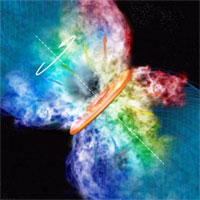A massive star is born
12 Feb 2010
A team of astronomers led by Lynn D. Matthews at the MIT Haystack Observatory has discovered a disk of gas swirling close to a young massive star, which they say offers the first evidence that massive stars form similarly to smaller stars. Because massive stars are believed to be responsible for creating most of the chemical elements in the universe that are critical for the formation of Earth-like planets and life, understanding how they form may help unravel mysteries about the origins of life.
 |
| Artist's conception of the rotating disk of hot, ionized gas surrounding Orion Source I, blocking the star from our view. A cool wind of gas is driven from the upper and lower surfaces of the disk and is sculpted into an hourglass shape by tangled magnetic field lines. Image: Bill Saxton, National Radio Astronomy Observatory/Associated Universities, Incorporated/National Science Foundation |
''It is the first really ironclad confirmation that massive young stars are surrounded by orbiting accretion disks, and the first strong suggestion that these disks launch magnetically driven winds,'' said University of California at Santa Cruz astronomy and astrophysics professor Mark Krumholz of the time-lapse movie, which is described in a paper published in the Jan. 1 issue of the Astrophysical Journal.
For almost 20 years, astronomers have known that low-mass stars form as a result of disk-mediated accretion, or from material formed from a structure rotating around a central body and driven by magnetic winds. But it had been impossible to confirm whether this was true for massive stars, which are eight to 100 times larger than low-mass stars. Without any hard data, theorists proposed many models for how massive stars might form, such as via collisions of smaller stars. ''This work should rule out many of them,'' Krumholz said of Matthews' movie.
Piercing the Dusty Cloud
A network of 10 radio telescope dishes located across North America, the VLBA can be thought of as a virtual telescope 5,000 miles in diameter, according to Matthews. Used as a zoom lens to penetrate the dusty cloud surrounding the massive star, the VLBA captured images up to 1,000 times sharper than those previously obtained by other telescopes, including NASA's Hubble Space Telescope.






























